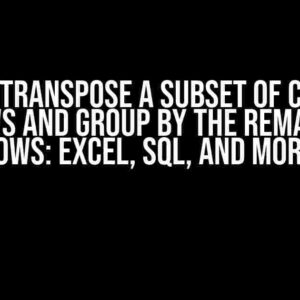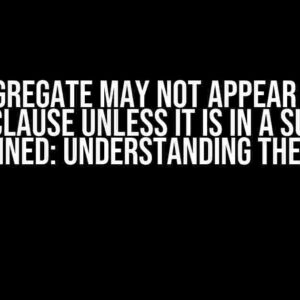Are you tired of encountering the frustrating “circular reference error” when working with recursive Common Table Expressions (CTEs)? Do you want to unlock the full potential of recursive CTEs and simplify your query writing process? Look no further! In this comprehensive guide, we’ll delve into the world of recursive CTEs, explore the causes of circular reference errors, and provide you with practical solutions to overcome them.
What is a Recursive CTE?
A recursive CTE is a type of CTE that references itself, allowing you to perform hierarchical or tree-like queries. It’s a powerful tool for solving complex problems, such as traversing organizational charts, generating hierarchies, or computing aggregations. However, with great power comes great responsibility – and sometimes, great frustration.
WITH RECURSIVE employee_hierarchy AS (
SELECT employee_id, manager_id, 0 AS level
FROM employees
WHERE manager_id IS NULL -- anchor query
UNION ALL
SELECT e.employee_id, e.manager_id, level + 1
FROM employees e
INNER JOIN employee_hierarchy m ON e.manager_id = m.employee_id -- recursive query
)
SELECT * FROM employee_hierarchy;
The Circular Reference Error: A Common Pitfall
One of the most frequent errors encountered when working with recursive CTEs is the circular reference error. This occurs when the recursive CTE references itself in a way that creates an infinite loop, causing the query to fail.
Here’s an example of a circular reference error:
WITH RECURSIVE bad_query AS (
SELECT 1 AS value
UNION ALL
SELECT value + 1
FROM bad_query -- reference itself directly
WHERE value < 10
)
SELECT * FROM bad_query;
This query will fail with a circular reference error because the recursive CTE references itself directly, creating an infinite loop.
Why Do Circular Reference Errors Occur?
Circular reference errors can occur due to several reasons, including:
- Direct self-reference: When the recursive CTE references itself directly, without any filtering or aggregation.
- Lack of anchor query: Failing to define an anchor query that provides a starting point for the recursion.
- Incorrect join order: Joining the recursive CTE with itself in the wrong order, causing an infinite loop.
- Missing or incorrect stopping condition: Failing to define a stopping condition that terminates the recursion.
Solving Circular Reference Errors: Best Practices and Techniques
To overcome circular reference errors, follow these best practices and techniques:
1. Define a Clear Anchor Query
Ensure your anchor query is well-defined and provides a solid starting point for the recursion. This query should return a fixed set of rows that serve as the foundation for the recursive process.
WITH RECURSIVE employee_hierarchy AS (
SELECT employee_id, manager_id, 0 AS level
FROM employees
WHERE manager_id IS NULL -- anchor query
UNION ALL
SELECT e.employee_id, e.manager_id, level + 1
FROM employees e
INNER JOIN employee_hierarchy m ON e.manager_id = m.employee_id
)
SELECT * FROM employee_hierarchy;
2. Use Aliases and Correct Join Order
Use aliases to differentiate between the anchor query and the recursive query, and ensure the join order is correct. This prevents the recursive CTE from referencing itself directly.
WITH RECURSIVE employee_hierarchy AS (
SELECT employee_id, manager_id, 0 AS level
FROM employees
WHERE manager_id IS NULL -- anchor query
UNION ALL
SELECT e.employee_id, e.manager_id, level + 1
FROM employees e
INNER JOIN employee_hierarchy m ON e.manager_id = m.employee_id -- correct join order
)
SELECT * FROM employee_hierarchy;
3. Implement a Stopping Condition
Define a stopping condition that terminates the recursion when a certain criteria is met. This prevents the recursive CTE from running indefinitely.
WITH RECURSIVE employee_hierarchy AS (
SELECT employee_id, manager_id, 0 AS level
FROM employees
WHERE manager_id IS NULL -- anchor query
UNION ALL
SELECT e.employee_id, e.manager_id, level + 1
FROM employees e
INNER JOIN employee_hierarchy m ON e.manager_id = m.employee_id
WHERE level < 5 -- stopping condition
)
SELECT * FROM employee_hierarchy;
4. Use Recursive CTE with Aggregate Functions
When using aggregate functions, such as SUM or AVG, ensure you’re using the correct syntax and avoiding direct self-reference.
WITH RECURSIVE sales_hierarchy AS (
SELECT sales_id, product_id, sales_amount, 0 AS level
FROM sales
WHERE product_id IS NULL -- anchor query
UNION ALL
SELECT s.sales_id, s.product_id, s.sales_amount, level + 1
FROM sales s
INNER JOIN sales_hierarchy m ON s.product_id = m.sales_id
GROUP BY s.sales_id, s.product_id, s.sales_amount, level -- aggregate function
)
SELECT * FROM sales_hierarchy;
5. Test and Optimize Your Query
Test your recursive CTE with a small dataset and gradually increase the size to ensure it’s performing correctly. Optimize your query by using efficient join orders, indexing, and reducing the number of recursive iterations.
Common Scenarios and Solutions
Here are some common scenarios where recursive CTEs are used, along with solutions to overcome circular reference errors:
Scenario 1: Hierarchical Query with Multiple Levels
In this scenario, you need to traverse a hierarchical structure with multiple levels.
WITH RECURSIVE org_chart AS (
SELECT employee_id, manager_id, 0 AS level
FROM employees
WHERE manager_id IS NULL -- anchor query
UNION ALL
SELECT e.employee_id, e.manager_id, level + 1
FROM employees e
INNER JOIN org_chart m ON e.manager_id = m.employee_id
)
SELECT * FROM org_chart;
Scenario 2: Recursive Aggregation with Grouping
In this scenario, you need to perform a recursive aggregation with grouping.
WITH RECURSIVE sales_hierarchy AS (
SELECT sales_id, product_id, sales_amount, 0 AS level
FROM sales
WHERE product_id IS NULL -- anchor query
UNION ALL
SELECT s.sales_id, s.product_id, SUM(s.sales_amount), level + 1
FROM sales s
INNER JOIN sales_hierarchy m ON s.product_id = m.sales_id
GROUP BY s.sales_id, s.product_id, level
)
SELECT * FROM sales_hierarchy;
Scenario 3: Handling Circular Dependencies
In this scenario, you need to handle circular dependencies in a hierarchical structure.
WITH RECURSIVE dependency_graph AS (
SELECT id, parent_id, 0 AS level
FROM dependencies
WHERE parent_id IS NULL -- anchor query
UNION ALL
SELECT d.id, d.parent_id, level + 1
FROM dependencies d
INNER JOIN dependency_graph m ON d.parent_id = m.id
WHERE m.level < 5 -- stopping condition
)
SELECT * FROM dependency_graph;
Conclusion
Recursive CTEs are a powerful tool for solving complex problems, but they can be prone to circular reference errors. By following best practices, understanding the causes of circular reference errors, and implementing solutions, you can master the art of recursive CTEs and unlock the full potential of your query writing skills.
Remember to define clear anchor queries, use aliases and correct join orders, implement stopping conditions, and test and optimize your queries. With these techniques, you’ll be well-equipped to tackle even the most challenging hierarchical and tree-like queries.
Additional Resources
For further reading and practice, we recommend the following resources:
- SQL Server documentation on recursive CTEs
- Tutorials Point’s guide to recursive CTEs
- Stack Overflow’s Q&A on recursive CTEs
| Scenario | Query | Solution |
|---|---|---|
| Hierarchical Query with Multiple Levels | WITH RECURSIVE org_chart AS … | Define clear anchor query and stopping condition |
| Recursive Aggregation with Grouping | WITH RE
Frequently Asked QuestionGet ready to unravel the mysteries of Recursive Common Table Expressions (CTEs) and learn how to overcome the dreaded circular reference error! What is a Recursive CTE and how does it work?A Recursive CTE is a temporary result set that is defined in terms of itself, allowing you to perform hierarchical or tree-like queries. It consists of three parts: an anchor query, a recursive query, and a UNION operator to combine them. The anchor query defines the starting point, while the recursive query defines the recursive operation. The UNION operator combines the results of the anchor and recursive queries, creating a loop that continues until a stopping criteria is met. What is a circular reference error, and why does it occur in Recursive CTEs?A circular reference error occurs when a Recursive CTE references itself indirectly, creating an infinite loop. This happens when the recursive query refers back to the anchor query, causing the CTE to reference itself infinitely. This error can be frustrating, but fear not, we’ve got solutions for you! How can I avoid a circular reference error in a Recursive CTE?To avoid a circular reference error, ensure that your anchor query and recursive query have distinct columns or criteria that prevent the CTE from referencing itself indefinitely. You can also use a MAX recursion level or a stopping criteria to terminate the recursion. Additionally, properly defining the anchor and recursive queries, and using column aliases can help prevent circular references. What are some common use cases for Recursive CTEs?Recursive CTEs are perfect for querying hierarchical or tree-like data, such as organizational charts, bill of materials, or recursive relationships. They can also be used for tasks like aggregating data, generating calendars, or creating hierarchical reports. Are there any performance considerations I should be aware of when using Recursive CTEs?Recursive CTEs can be resource-intensive, especially for large datasets. To optimize performance, use indexes, limit the recursion level, and optimize your anchor and recursive queries. Additionally, consider using alternative methods, such as iterative queries or hierarchical queries, if possible. |



